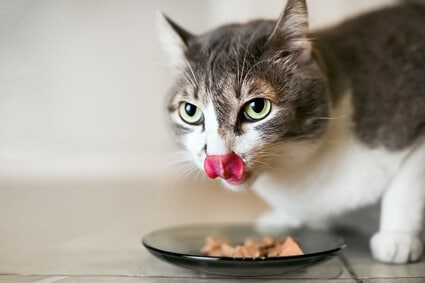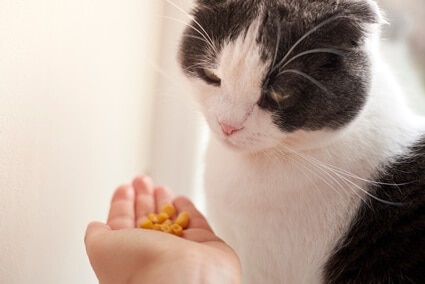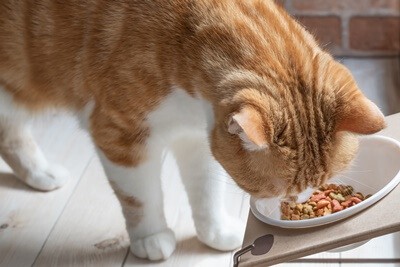If we were given the same plate of food for every meal, day in and day out, most of us would soon get bored. However, many owners wonder if cats will have the same unfavorable reaction.
Cats show an affinity for flavor, texture, and the overall eating experience. In their natural environment, cats benefit from consuming a variety of different prey, so feeding cats the same food every day is – as it would be to humans – really boring.
Cats don’t speak the same language as humans, so they can’t tell us that they’re displeased with their food. Fortunately, their feeding habits provide us with valuable insight.
Do Cats Get Bored with Their Food?
To understand the relationship between cats and their food, we need to identify what specifically drives us to purchase pet food when we’re shopping.
In a study from the Canadian Veterinary Journal, the purchasing decision by most cat owners is dependent on four main things:
- The relationship between the cat and its owner
- The price and value of cat foods
- Quality and the idea that commercial produce isn’t always best
- The ideologies of the owner and where they get their information
The more you humanize the cat, the more likely you will transfer your own eating habits and dietary beliefs onto your cat. This chain of thought is responsible for everything from vegan pet diets to healthy eating habits generally.
Also, we need to consider brand loyalty and the idea that if you have always bought the same pet food brand in the past and been happy with the product, you’ll continue to do the same in the future.
This leaves cats, especially domesticated indoor cats, with no choice about their food intake. However, as consumers, we rely on pet food manufacturers to deliver the nutrition and taste that we want for our cats.
Do Cats Care About Food Variety?
In a study by Science Direct, it was concluded that domestic cats show a preference for foods based on relative abundance, novelty, and the potential for bad reactions, such as vomiting.
Cats are turned off by the possibility that something they eat could make them sick. The other two explanations are connected to the experience. The chance to secure plentiful food and the opportunity for novel and new food experiences are factors that influence the cat’s decision to indulge.
This study shows that domesticated house cats have shown definitive preferences for novel foods. That is, they provide a different taste and eating experience.
The conclusion was that domestic cats are far more likely to reduce their need for food based on palatability, which again shows us that cats are far more likely to reduce their food intake and adapt their energy usage based on food availability and how much they want to eat it.
These findings show that cats have a definite reaction to the taste of food, tending to prefer novel foods and foods that provide different experiences.
We can conclude that cats care about food variety, which can account for the amount of food they eat.
Do I Need To Change My Cat’s Diet?
If cats get bored of the same food, does this mean we should regularly change their diet? Well, there are several factors to consider.
While a change in food can provide novelty, owners must remember that different cat foods and brands contain different nutrients.
If your cat responds well to a certain type or brand of food in terms of what it contains, it’s important to ensure that any change in food reflects the same nutrient levels and ingredient types.
Some ideas, before we look more closely into the specifics of changing a cat’s diet, include:
- Trying new flavours of the same food or brand of food
- Adding a touch of hot water to dry food, to change the texture
- Mixing foods together to benefit from a range of brands or products
- Changing the conditions in which food is presented and served
A mix-and-match approach can give your cat the variety of flavor and eating experience while still maintaining the same health benefits that you know your cat is enjoying from its current dietary regimen.

Changing The Eating Habits of My Cat
There are many cases where an owner has sought to change their cat’s eating habits, only to find that their cat turns its nose up at the new food.
One of the issues with dry cat food, in particular, is the lack of hydration it brings, with dry food becoming particularly difficult for aging cats to process and digest. But that’s not all.
Aging plays a part in the eating habits of cats. This study from The Aging Feline discusses the changing requirements of cats as they age in terms of nutrients, calories, water content, and digestibility.
So, if you plan on changing your cat’s eating habits, you need to identify why you’re making the change. The most common reasons include changing your cat’s eating habits to introduce greater variety, altering their food to be more age-appropriate, and changing their habits based on dietary needs.
Nutrition
If you plan on changing your cat’s dry food, assess the nutritional content of the old and new food and ensure that you’re giving them the same nutrients they need to thrive.
According to the Canadian Journal of Veterinary Research, the nutritional value of cat food is important. It should be linked to their needs in terms of energy, internal health, and the need for specific ingredients.
Dry vs. Wet food
The primary reason for choosing wet food over dry food or giving your cat a combination of wet and dry food lies in the hydrational value.
According to Science Direct, while food preference isn’t necessarily impacted by the moisture content in the food, feeding your cat wet food supports their need for optimum hydration.
According to Research Gate, cats consume less when fed dry over wet food, which means that palatability isn’t necessarily the only factor responsible for the amount of food consumed. Clearly, the texture and makeup of the food are just as important.
So, we have yet more proof that cats are heavily influenced by more than just the flavor.

Nature vs. Nurture
Interestingly, while cats and other animals hold certain preferences regarding the food they eat, most cats will eat what is presented to them.
Far from the complexity of our tastebuds and eating preferences with regards to flavor and texture, cats will eat what they can regardless of whether they want it or not.
The most obvious difference in their preference and desire will be apparent in the amount they eat, rather than whether or not they consume the food.
In short, your cat will eat something because it’s there. However, that doesn’t mean they enjoy it or aren’t bored of eating it continuously.
Serving Food
The feeding regimen you follow can significantly impact your cat’s eating habits.
For example, if food is always available in your cat’s bowl, the chances of them showing an interest in that food is lower. If you feed them at a set time, you’ll find it easier to monitor and see how the change of food impacts their appetite and the amount they consume.
The bowl that your cat eats out of is another thing that can have an unexpected impact on their eating habits, with deep bowls more difficult to access. It may look like your cat is disinterested in its food or growing bored of its diet, but have you checked that they can access every morsel?
In its simplest form, this means that it may not be taste and food preferences that determine your cat’s eating habits; the serving regimen plays a significant part, too.
The fact is that cats display a level of preference for certain types of food and are drawn in by novelty and the opportunity to eat different things.
However, cats are driven by the need to eat what is in front of them. When we select a food type for our cats, it’s in their nature to eat what’s there, whether or not they want it.
The main factor in understanding how cats feel about their food is how much they eat. Beyond that, pay attention to any nutrients and ingredients, ensuring that your cat gets the vitamins it needs and what it’s consuming is suitable for its size, breed, and age.

